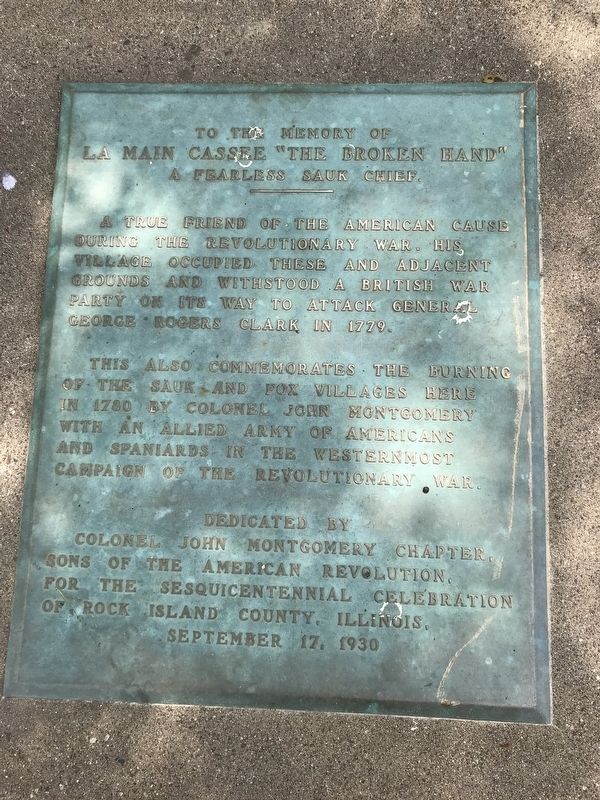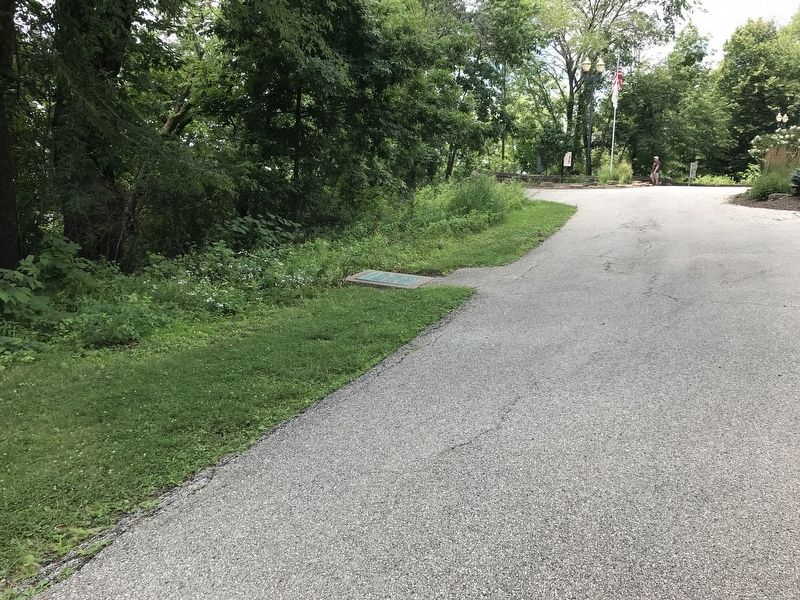Rock Island in Rock Island County, Illinois — The American Midwest (Great Lakes)
To the Memory of La Main Cassee "The Broken Hand," a Fearless Sauk Chief
Inscription.
A true friend of the American cause during the Revolutionary War. His village occupied these and adjacent grounds and withstood a British war party on its way to attack General George Rogers Clark in 1779.
This also commemorates the burning of the Sauk and Fox villages here in 1780 by Colonel John Montgomery with an allied army of Americans and Spaniards in the westernmost campaign of the Revolutionary War.
Colonel John Montgomery Chapter,
Sons of the American Revolution,
for the sesquicentennial celebration
of Rock Island County, Illinois
September 17, 1930
Erected 1930 by Colonel John Montgomery Chapter, Sons of the American Revolution.
Topics and series. This historical marker is listed in these topic lists: Native Americans • War, US Revolutionary. In addition, it is included in the Sons of the American Revolution (SAR) series list. A significant historical year for this entry is 1779.
Location. 41° 27.849′ N, 90° 34.356′ W. Marker is on Rock Island, Illinois, in Rock Island County. Marker can be reached from 46th Avenue (Illinois Route 3) 0.3 miles east of 15th Street, on the right when traveling east. Marker is on the Black Hawk State Historic Site Trail behind the Hauberg Indian Museum. Touch for map. Marker is at or near this postal address: 1510 46th Ave, Rock Island IL 61201, United States of America. Touch for directions.
Other nearby markers. At least 8 other markers are within 3 miles of this marker, measured as the crow flies. The Black Hawk Inns (a few steps from this marker); Black Hawk: Saux Warrior (within shouting distance of this marker); Illinois in the American Revolution (within shouting distance of this marker); Figure Eight Roller Coaster and Balloon Ascension Tower (about 300 feet away, measured in a direct line); Soldiers and Sailors Monument (approx. 1.3 miles away); Chippiannock Cemetery (approx. 1.3 miles away); Lincoln and the Black Hawk War (approx. 1˝ miles away); Robert Wagner House (approx. 2.6 miles away). Touch for a list and map of all markers in Rock Island.
Regarding To the Memory of La Main Cassee "The Broken Hand," a Fearless Sauk Chief. Excerpt from Indian Villages of the Illinois Country by Wayne C. Temple, the Illinois State Museum's Curator of Ethnohistory (1958):
Charles Gautier, a British subject … was at the mouth of Rock River again on April 4, 1779, and found one band of Sauk there who were friends of the Americans. La Main Casse (Broken Hand) was their chief and he not only refused to let the Britisher pass but also took some prisoners away from him. Before reachingthe Rock, Gautier had observed another band of Sauk living on the Wisconsin and declared that the Sauk tribe was divided into separate groups with different allegiances. It was this split among the Sauk that worked to the advantage of the Americans. The British mistakenly concluded that they had convinced the Sauk and Fox to attack the American forts during the winter of 1779-1780, but those of the two tribes who were loyal to the Americans kept the remainder from an open assault upon the United States.
However, on May 26, 1780, a band of British and their Indian allies swept down the Illinois River from Chicago and attacked St. Louis, but they failed to capture the Spanish fort and the following day were likewise driven away from Cahokia. Col. John Montgomery then collected a force of 350 men who pursued the retreating Indians up the Illinois River, destroyed some Indian villages at Peoria, and marched on to the Rock River where they burned the villages of the Sauk and Fox. It is said that these two tribes could muster 700 warriors, but they were disbanded and unable to defend their towns.
Credits. This page was last revised on July 11, 2022. It was originally submitted on July 11, 2022, by Duane and Tracy Marsteller of Murfreesboro, Tennessee. This page has been viewed 270 times since then and 87 times this year. Photos: 1, 2. submitted on July 11, 2022, by Duane and Tracy Marsteller of Murfreesboro, Tennessee.

